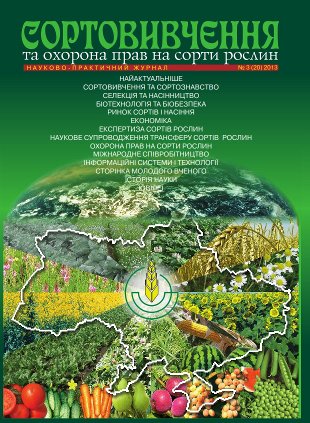Considering scientific application of RHS biological scale for plant varieties identification
DOI:
https://doi.org/10.21498/2518-1017.3(20).2013.58334Keywords:
color, coloration, hue, plant, color scale, identification, code of expression, range, scale, RHS, variety, morphological description, artificial lightning, UK StandardAbstract
Living organisms in nature harmonize through the medium of light spectrum and sound vibration. Therefore the issue of applying the scientific customization of color scale to identification of vegetative and generative parts of plans remain up to date, namely: identification if states of expression for hues of green color of stem and foliage, variability of color range for petals of follower corolla, coloration of pericarp and seed etc. A scientific rationale is provided to the application of RHS during the qualifying examination of plant varieties by way of identification – morphological description. This also disclosed the application of RHS to visualize various qualitative and pseudo-qualitative morphological characteristics of vegetative and generative parts of plants. The performed chronological monitoring of stag-by-stage introduction of standardization of living biological items enabled to establish a customized gradation of colors and their hues expression. Ensuring completeness of the morphological code formula for plant varieties requires compulsory identification of their colors and hues, as the Guidelines for the conduct of test on distinctness, uniformity and stability so provide for relevant botanical taxon.Downloads
References
Базима, Б.А. Взаимосвязь цветовых предпочтений и идентификации с цветом // Материалы конференции «Актуальные вопросы практической психологии и логопедии в учреждениях образования и охраны здоровья Украины». – Харьков, 1998. – С. 106–109 // URL: http://www.colorpsy.boom.ru/Colorident.htm
Бразман, М.Э. О дифференциации некоторых эмоциональных состояний методом измерения цветовой чувствительности / М.Э. Бразман, Э.Т. Дорофеева, В.А. Щербатов // Проблемы моделирования психической деятельности. – Новосибирск, 1967. – С. 171–174.
Люшер, М. Четырехцветный человек или путь к внутреннему равновесию // Магия цвета: сб. – Харьков: Сварог, АО Сфера, 1996. – 432 c.
http://uk.wikipedia.org/wiki/Колір: (дата звернення 07.05.2013).
Базима, Б.А. О цветовом выборе как индикаторе эмоциональных состояний в процессе решения малых творческих задач / Б.А. Базима, Н.А. Густяков // Вестник ХГУ. – Харьков, 1988. – N 320. – С. 22–25 // URL: http://www.colorpsy.boom.ru/Think3.htm
TGP/7/3 DEVELOPMENT OF TEST GUIDELINES / Adopted by the Council at its forty-fifth ordinary session on October 20, 2011 // URL: http://www.upov.int/edocs/tgpdocs/en/tgp_7.pdf: (дата звернення 07. 05. 2013)
ru.wikipedia.org/wiki/Атлас_цветов: (дата звернення 08.05.2013)
http://www.elvas.com.ua/ukr/ral.php: (дата звернення 13.05.2013)
http://www.rhs.org.uk/Plants/RHS-Publications/RHS-colour-charts: (дата звернення 13.05.2013)
Downloads
Published
How to Cite
Issue
Section
License
Copyright (c) 2013 Ukrainian Institute for Plant Variety Examination

This work is licensed under a Creative Commons Attribution-ShareAlike 4.0 International License.
Starting in 2022, the copyright to the publication remains with the authors
Our journal abides by the CREATIVE COMMONS copyright rights and permissions for open access journals.
Authors, who are published in this journal, agree to the following conditions:
- The authors reserve the right to authorship of the work and pass the first publication right of this work to the journal under the terms of a Creative Commons Attribution License, which allows others to freely distribute the published research with the obligatory reference to the authors of the original work and the first publication of the work in this journal.
- The authors have the right to conclude separate supplement agreements that relate to non-exclusive work distribution in the form in which it has been published by the journal (for example, to upload the work to the online storage of the journal or publish it as part of a monograph), provided that the reference to the first publication of the work in this journal is included.

























 Ukrainian Institute for Plant Varieties Examination
Ukrainian Institute for Plant Varieties Examination  Селекційно-генетичний інститут
Селекційно-генетичний інститут Institute of Plant Physiology and Genetics of the National Academy of Sciences of Ukraine
Institute of Plant Physiology and Genetics of the National Academy of Sciences of Ukraine
 The National Academy of Agrarian Sciences of Ukraine
The National Academy of Agrarian Sciences of Ukraine